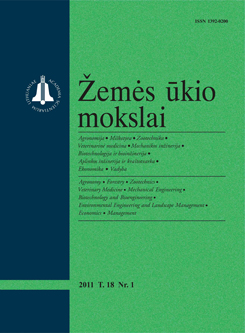 ISSN 1392-0200 |
2008 m. Nr. 4 Dependence of crop residues decomposing in soil on their chemical composition and environmental conditions
Decomposition of crop residues was studied at the Experimental Station of the Lithuanian University of Agriculture in a model field experiment in the period 2003–2005. The soil of the experimental site is drained moraine loamy Endocalcari-Epihypogleyic Cambisol (sicco). The aim of the investigation was to establish the decomposition intensity of oilseed rape residues in soil and its dependence on residue chemical composition and environmental conditions in comparison with wheat and clover residues. During 26.5 months of crop residue decomposition in soil and a decrease of dry matter and organic carbon content, the C : N ratio was also decreasing. The concentration of lignin in decomposing crop residues was relatively increasing during the first 14.5 months. After 19.5 months, in all crop residues the concentration of lignin was lower, but a significant decrease was found after 26.5 months of their incubation in soil. The most intensive decomposition of oilseed rape threshing remains (winter rape 24.4 and spring rape 23.6% mth–1), stubble of wheat (22.1% mth–1) and clover (23.4% mth–1) was recorded during the first three months of incubation in soil. The stubble of winter and spring oilseed rape decomposed slower: during warm periods the intensity of decomposition was 2.6–6.0 and 5.6–8.4% mth–1, respectively. Wheat and clover roots decomposed most intensively during the first (both 8.2% mth–1) and second (respectively 6.7 and 8.1% mth–1) warm periods and oilseed rape roots during the second (w. rape 4.3, s. rape 9.1% mth–1) and third (w. rape 3.8% mth–1) warm periods. After 26.5 months, the stubble of winter and spring oilseed rape was decomposed less (respectively 68 and 77%) than their threshing remains (both 93%), the stubble of wheat (86%) and clover (95%). Winter oilseed rape roots were decomposed significantly less (59%) than roots of spring oilseed rape (75%), wheat (80%) and clover (82%). The correlation between dry matter content and C : N ratio in oilseed rape stubble and the roots of oilseed rape, winter wheat and red clover was strong positive (r = 0.93**–0.97**), while in other residues it was weaker (r = 0.74**–0.84**). In terraneous residues of oilseed rape, the content of dry matter strongly correlated with the content of lignin (r = from –0.78** to –0.87**). In the stubble of winter wheat and red clover, the correlation between these indices was modest – respectively r = –0.52** and r = –0.64**. In spring oilseed rape roots, the correlation between the content of dry matter and lignin was very strong (r = –0.93**), in the roots of winter oilseed rape (r = 0.86**) and wheat (r = 0.85**) strong, and in clover roots there were no correlation between these indices. The temperature of air and soil, the sum of these temperatures (≥5 °C) and precipitation had a stronger influence on crop residue decomposition per period than on their decomposition intensity per month. In rape stubble, the correlation between these agrometeorological indices and decomposition intensity during the period (r = 0.89**–0.98**) and per month (r = 0.50*–0.94**) was stronger than in their threshing remains(r = 0.48*–0.78**) and wheat or clover stubble (r = 0.45*–0.85**). Decomposition intensity of winter rape roots per month depended on agrometeorological conditions (r = 0.80**–0.85**) more than did other residues (r = 0.57**–0.80**). Decomposition of rape roots per period was influenced mostly by precipitation (winter rape r = 0.94**, spring rape r = 0.71**), while decomposition of wheat and clover roots by temperature (r = 0.84**–0.92**). Keywords: winter and spring oilseed rape, winter wheat, red clover residues, C : N, lignin, temperature, precipitation, correlation |
Numeriai:
2012 - T.19 Nr.1 2011 - T.18 Nr.1, Nr.2, Nr.3, Nr.4 2010 - T.17 Nr.1-2, Nr.3-4 2009 - T.16 Nr.1-2, Nr.3-4 2008 - T.15 Nr.1, Nr.2, Nr.3, Nr.4 2007 - T.14 Nr.1, Nr.2, Nr.3, Nr.4, Nr.Priedas 2006 Nr.1, Nr.1.Priedas, Nr.2, Nr.3, Nr.4 2005 Nr.1, Nr.2, Nr.3, Nr.4 2004 Nr.1, Nr.2, Nr.3, Nr.4 2003 Nr.1, Nr.2, Nr.3, Nr.4 2002 Nr.1, Nr.2, Nr.3, Nr.4 2001 Nr.1, Nr.2, Nr.3, Nr.4 |